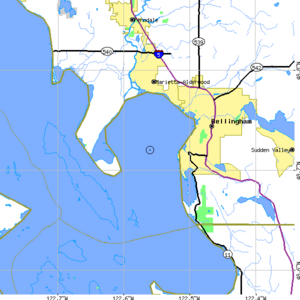Bellingham Bay facts for kids
Bellingham Bay is a beautiful bay located in Washington State, USA. It is part of the larger Salish Sea. To the west, the bay is separated from the Strait of Georgia by the Lummi Peninsula, Portage Island, and Lummi Island. On the east, you'll find the city of Bellingham, Washington. The Chuckanut Mountains are to the southeast, and Samish Bay is to the south. Two rivers, the Nooksack River and Whatcom Creek, flow into the bay.
Bellingham Bay was named after Sir William Bellingham. He was a British Navy official when the Vancouver Expedition explored the bay in June 1792. Before that, a Spanish ship called the Santa Saturnina explored the bay in 1791. Its captain, José María Narváez, first named it Seno Gaston.
Fun Events

The city of Bellingham hosts a popular run and walk event called the Bellingham Bay Marathon. This event offers different races, including a full marathon, a half marathon, a 10k, and a 5k. The Bellingham Bay Marathon is a special race because it can help runners qualify for the famous Boston Marathon. All the race courses are officially certified.
The Bellingham Bay Marathon started in 2003. It was created by the Bellingham Bay Swim Team. A great thing about this event is that all the money it raises goes to help youth non-profit groups in Whatcom County.
Cleaning Up the Bay
Working Together for a Cleaner Bay
In 1996, different groups came together to form the Bellingham Bay Demonstration Pilot team. This team included federal, state, and local governments, along with tribal groups. Their main goal was to find ways to clean up pollution in the bay. They also wanted to stop new pollution sources and help restore the natural homes for animals and plants.
The team also thought about how people use the land and water around the bay's cleanup sites. The Department of Ecology and the Port of Bellingham manage this team together. The Department of Ecology is the main agency leading the effort. The pilot team is working on a plan for 12 important cleanup sites around the bay. In 2013, new rules were set to help identify and clean up polluted areas at the bottom of the bay.


